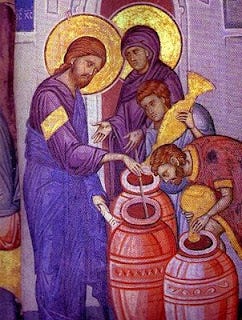The Better Wine

Mary, called in the gospel "the mother of Jesus," appears twice in the gospel of John. At the beginning and at the end. And in both cases thirst and wine are involved.
The first story is the wedding feast at Cana, where Jesus turns water into wine because the wedding hosts had run out:
John 2.1-10
On the third day a wedding took place at Cana in Galilee. Jesus’ mother was there, and Jesus and his disciples had also been invited to the wedding. When the wine was gone, Jesus’ mother said to him, “They have no more wine.” “Woman, why do you involve me?” Jesus replied. “My hour has not yet come.” His mother said to the servants, “Do whatever he tells you.” Nearby stood six stone water jars, the kind used by the Jews for ceremonial washing, each holding from twenty to thirty gallons. Jesus said to the servants, “Fill the jars with water”; so they filled them to the brim. Then he told them, “Now draw some out and take it to the master of the banquet.” They did so, and the master of the banquet tasted the water that had been turned into wine. He did not realize where it had come from, though the servants who had drawn the water knew. Then he called the bridegroom aside and said, “Everyone brings out the choice wine first and then the cheaper wine after the guests have had too much to drink; but you have saved the best till now.”
Jesus initially resists the request saying that his "time has not yet come." What time is that exactly? The master of the banquet also makes the observation that the "cheaper" wine comes early and the better wine comes out later.
That's all very interesting. We are left leaning into the story wondering when Jesus's "hour" will come and the better wine be poured out.
And wine, along with Mary, does appear again later in the story, drawing our attention and forming a connection between the wine of Cana and the blood poured out on the cross:
John 19.25-35
Near the cross of Jesus stood his mother, his mother’s sister, Mary the wife of Clopas, and Mary Magdalene. When Jesus saw his mother there, and the disciple whom he loved standing nearby, he said to her, “Woman, here is your son,” and to the disciple, “Here is your mother.” From that time on, this disciple took her into his home. Later, knowing that everything had now been finished, and so that Scripture would be fulfilled, Jesus said, “I am thirsty.” A jar of wine vinegar was there, so they soaked a sponge in it, put the sponge on a stalk of the hyssop plant, and lifted it to Jesus’ lips. When he had received the drink, Jesus said, “It is finished.” With that, he bowed his head and gave up his spirit.
Now it was the day of Preparation, and the next day was to be a special Sabbath. Because the Jewish leaders did not want the bodies left on the crosses during the Sabbath, they asked Pilate to have the legs broken and the bodies taken down. The soldiers therefore came and broke the legs of the first man who had been crucified with Jesus, and then those of the other. But when they came to Jesus and found that he was already dead, they did not break his legs. Instead, one of the soldiers pierced Jesus’ side with a spear, bringing a sudden flow of blood and water. The man who saw it has given testimony, and his testimony is true. He knows that he tells the truth, and he testifies so that you also may believe.
Is this the time, "the hour" that Jesus was referring to at Cana? Is this what the miracle of Cana was pointing toward all along, the true miracle of "turning water into wine"? Is the blood of Jesus the "better wine" that comes out at the end of the story, the observation made by the master of the wedding feast at Cana?
Consider the Eucharistic overtones.
Is not the wine enjoyed in the Eucharist the "better wine" of our own wedding banquet?



